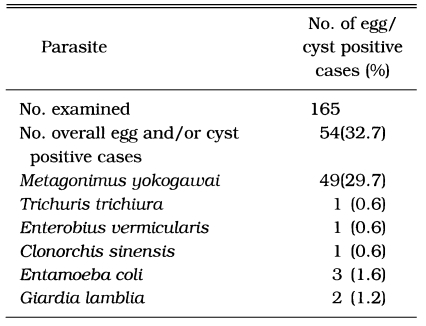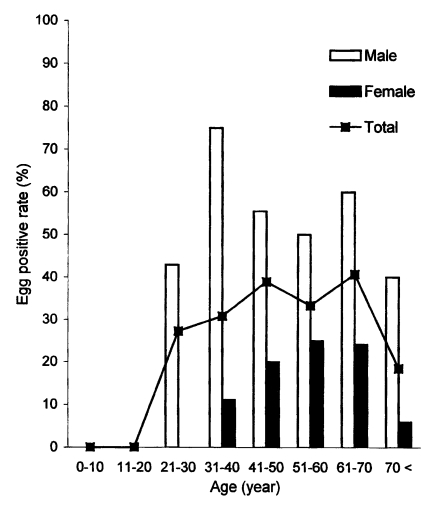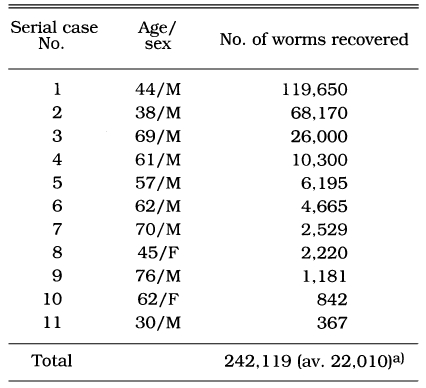Abstract
A small-scale epidemiological survey was undertaken during 1997-1998 on the residents along the Osib-chon (Stream), Samchok-shi (City), Kangwon-do (Province), to evaluate the status of Metagonimus yokogawai infection. A total of 165 fecal samples was collected and examined by cellophane thick smear and formalin-ether sedimentation techniques. The egg positive rate of M. yokogawai was 29.7%, showing a remarkable difference between males (46.6%) and females (16.3%). To obtain the adult flukes of M. yokogawai, 11 egg positive persons were treated with praziquantel and purged with magnesium sulfate. A total of 242,119 adult flukes (average 22,010 per person, 367-119,650 in range) was collected from diarrheic stools, all of which were identified as M. yokogawai. The results show that M. yokogawai is still highly endemic in this area.
Keywords: Metagonimus yokogawai, human infection, Samchok-shi, epidemiology
Of many species of heterophyid flukes known to occur in Korea, Metagonimus yokogawai is the most important one with respect to general public health (Chai and Lee, 1990). In heavily infected patients the infection can cause severe gastrointestinal troubles and easy fatiguability. Metagonimus yokogawai is widely distributed along the riverside areas of the southern and eastern coasts where sweetfish are available (Seo et al., 1982; Chai and Lee, 1990). In areas near Samchok-shi, Kangwon-do, a few epidemiological studies have been performed (Seo et al., 1981; Ahn, 1984; Song et al., 1985). However, worm collection studies that determine the intensity of infection have never been carried out along the eastern coasts including Samchok-shi. The present study was, therefore, aimed to investigate the prevalence and the intensity of M. yokogawai infection among the residents along the Osib-chon (Stream), Samchok-shi (City), Kangwon-do (Province).
Fecal specimens were collected from 165 people, including both sexes and all age groups, residing in two small villages (Sanggoro-ri and Hagoro-ri) in Miro-myon, Samchok-shi, during the period from November 1997 through January 1998. They were examined by both cellophane thick smear and formalin-ether sedimentation techniques. After the fecal examination, some of the cases showing a high number of eggs were treated with 10 mg/kg single dose of praziquantel, followed by purgation with 30-40 g of MgSO4. Among the treated cases, 11 were cooperative in collection of diarrheic stools more than five consecutive times during 3-4 hr directly after the treatment. Diarrheic stools were washed several times with tap water, and the sediment was fixed with 1% formalin and transported to our laboratory. The flukes were collected under a stereomicroscope and the number was counted. Some of the specimens were flattened gently under a cover slip pressure, which were fixed with 10% neutral buffered formalin and stained with Semichon's acetocarmine.
Through the fecal examination, various kinds of helminth eggs and protozoan cysts were detected (Table 1). Overall egg and/or cyst positive rate was 32.7% (54 out of 165 examined). The egg positive rate of helminths was the highest for M. yokogawai (29.7%) followed by Trichuris trichiura (0.6%), Enterobius vermicularis (0.6%), and Clonorchis sinensis (0.6%). The cyst positive rate was relatively low; Entamoeba coli (1.6%) and Giardia lamblia (1.2%).
Table 1.
Results of fecal examination of the residents in Samchok-shi, Kangwon-do (1997-1998)a)
a)Fecal examination was done by both cellophane thick smear and formalin-ether sedimentation techniques.
In the case of M. yokogawai infection, the highest egg positive rate was observed in the age group of 61-70 years (40.7%), followed by the forties (38.9%) and the fifties (33.3%) (Fig. 1). Among the younger age groups, less than 20 years, no infected cases were detected. The positive rate was significantly higher (p<0.05) for the males (46.6%) than the females (16.3%). From 11 cooperative cases in collection of adult flukes, a total of 242,119 adult specimens (average 22,010 per person, 367-119,650 in range) were collected (Table 2). All the flukes was identified as M. yokogawai. Most of the infected people, especially those with more than 10,000 worms, recalled that they had experienced mild to severe degrees of gastrointestinal troubles including episodes of diarrhea and colicky pain. Many of the infected people admitted that they had eaten raw freshwater fish (Plecoglossus altivelis) caught around this area.
Fig. 1.
Metagonimus yokogawai egg positive rates by age and sex of residents in Samchok-shi, Kangwon-do.
Table 2.
Number of M. yokogawai specimens collected from egg positive cases after praziquantel treatment and purgation
a)Average number of worms recovered per person
In Korea, three species of Metagonimus are known to occur; M. yokogawai (Chai and Lee, 1990), M. miyatai (Chai et al., 1993; Saito et al., 1997), and M. takahashii (Ahn and Ryang, 1988; Chai et al., 1993). However, the majority of epidemiological studies have been conducted on M. yokogawai (Seo et al., 1981; Song et al., 1985; Chai and Lee, 1990). Large and small rivers in the eastern and southern coastal areas, where sweetfish are available, have turned out to be endemic foci of M. yokogawai infection (Chai and Lee, 1990; Chai et al., 1998). According to a survey along the five major rivers, the average egg positive rate of riverside people was 4.8% (Seo et al., 1981). Other studies have revealed that the Somjingang (River), Tamjingang (River), Bosonggang (River), and Kojedo (Island) were found to be highly endemic with 10-40% egg positive rates among the residents (Yeo and Seo, 1971; Soh et al., 1976; Chai et al., 1977; Seo et al., 1981). In general population, however, quinquennial national surveys showed 1.2% egg positive rate in 1981, 1.0% in 1986, and 0.3% in 1992 and 1997 (Ministry of Health and Welfare and Korea Association of Health, 1997).
Around this area, two epidemiological surveys were performed on M. yokogawai infection previously (Seo et al., 1981; Ahn, 1984). According to the former report (Seo et al., 1981), the egg positive rate was 28.5%, a figure very similar to the present study. Compared to the latter (Ahn, 1984) in which the rate was reported as 35.4%, only a little decrease was recognized in the present study. This persistent endemicity of M. yokogawai in this area is undoubtedly related to a continued raw eating habbit of sweetfish by the local residents, especially among the adult age group. It is noteworthy, however, to mention that no school children were found to be infected, which could be a result from a successful health education among this age group. In other areas of the eastern coasts, variable infection rates of residents were reported previously; 9.4% in Ulchu-gun (Joo and Park, 1982), 23.1% in Ulchin-shi, and 6.7% in Miryang-gun (Seo et al., 1981), all of which showed lower prevalences than in the present study.
As far as the intensity of infection in terms of the number of worms in each person is concerned, there have been a few reports in Korea. A report of two cases who expelled 17,560 and 154 worms after a treatment was the first which documented the intensity of infection (Seo et al., 1971). Near the basin of Tamjin River, where the egg positive rate of M. yokogawai was 40.3%, the intensity of infection in average EPG (eggs per gram of feces) was 1,707 (Chai et al., 1977). It seems worthwhile to note that 2,886-63,587 adult flukes were collected individually from 14 infected people in Tamjin River basin (Seo et al., 1985), which became the most recent record on the worm burden of M. yokogawai. Therefore, the worm burdens of 119,650 (patient No. 1) and 68,170 (patient No. 2) in this study are the heaviest record among the literature. The infected people experienced mild to severe degrees of gastrointestinal troubles including diarrhea, and the two heaviest cases recalled that they had repeated episodes of profuse diarrhea and colicky pain.
Taken together, the results of the present study suggest that M. yokogawai is still highly endemic along the Osib-chon (Stream), Samchok-shi. Proper control measures are urgently needed in this area.
References
- 1.Ahn YK. Epidemiological studies on Metagonimus yokogawai infection in Samcheok-gun, Kangwon-do, Korea. Korean J Parasitol. 1984;22:161–170. doi: 10.3347/kjp.1984.22.2.161. (in Korean) [DOI] [PubMed] [Google Scholar]
- 2.Ahn YK, Ryang YS. Epidemiological studies on Metagonimus infection along the Hongcheon River, Kangwon Province, Korea. Korean J Parasitol. 1988;26:207–213. doi: 10.3347/kjp.1988.26.3.207. (in Korean) [DOI] [PubMed] [Google Scholar]
- 3.Chai JY, Cho SY, Seo BS. Study on Metagonimus yokogawai (Katsurada, 1912) in Korea IV. An epidemiological investigation along Tamjin River basin, South Cholla Do, Korea. Korean J Parasitol. 1977;15:115–120. doi: 10.3347/kjp.1977.15.2.115. [DOI] [PubMed] [Google Scholar]
- 4.Chai JY, Huh S, Yu JR, Kook J, Jung KC, Park EC, Sohn WM, et al. An epidemiological study of metagonimiasis along the upper reaches of the Namhan River. Korean J Parasitol. 1993;31:99–108. doi: 10.3347/kjp.1993.31.2.99. [DOI] [PubMed] [Google Scholar]
- 5.Chai JY, Lee SH. Intestinal trematodes of humans in Korea: Metagonimus, heterophyids and echinostomes. Korean J Parasitol. 1990;28(suppl):103–122. doi: 10.3347/kjp.1990.28.suppl.103. [DOI] [PubMed] [Google Scholar]
- 6.Chai JY, Song TE, Han ET, Guk SM, Park YK, Choi MH, Lee SH. Two endemic foci of heterophyids and other intestinal fluke infections in southern and western coastal areas in Korea. Korean J Parasitol. 1998;36:155–161. doi: 10.3347/kjp.1998.36.3.155. [DOI] [PMC free article] [PubMed] [Google Scholar]
- 7.Joo CY, Park SG. Epidemiological survey of Metagonimus yokogawai in Ulju county, Kyungnam Province, Korea. Kyungpook Univ Med J. 1982;23:1–9. [Google Scholar]
- 8.Ministry of Health and Welfare, Korean Association of Health. Prevalence of intestinal parasitic infections in Korea - The sixth report - Seoul, Korea: 1997. (Monograph series in Korean) [Google Scholar]
- 9.Saito S, Chai JY, Kim KH, Lee SH, Rim HJ. Metagonimus miyatai sp. nov. (Digenea: Heterophyidae), a new intestinal trematode transmitted by freshwater fishes in Japan and Korea. Korean J Parasitol. 1997;35:223–232. doi: 10.3347/kjp.1997.35.4.223. [DOI] [PubMed] [Google Scholar]
- 10.Seo BS, Hong ST, Chai JY, Lee SH. Study on Metagonimus yokogawai (Kasturada, 1912) in Korea VI. The geographical distribution of metacercarial infection in sweetfish along the east and south coast. Korean J Parasitol. 1982;20:28–32. doi: 10.3347/kjp.1982.20.1.28. (in Korean) [DOI] [PubMed] [Google Scholar]
- 11.Seo BS, Lee HS, Chai JY, Lee SH. Intensity of Metagonimus yokogawai infection among inhabitants in Tamjin River basin with reference to its egg laying capacity in the human host. Seoul J Med. 1985;26:207–212. [Google Scholar]
- 12.Seo BS, Lee SH, Cho SY, Chai JY, Hong ST, Han IS. An epidemiologic study on clonorchiasis and metagonimiasis in riverside areas in Korea. Korean J Parasitol. 1981;19:137–150. doi: 10.3347/kjp.1981.19.2.137. (in Korean) [DOI] [PubMed] [Google Scholar]
- 13.Seo BS, Rim HJ, Lee HS, Cho SY, Kwack CW, Lee WJ, Yeo TO. Two cases of metagonimiasis with special reference on the egg laying capacity in the human host. Seoul J Med. 1971;12:234–241. [Google Scholar]
- 14.Soh CT, Lee KT, Cho KM. Prevalences of clonorchiasis and metagonimiasis along rivers in Jeonra-Nam-Do, Korea. Yonsei Rep Trop Med. 1976;7:3–16. [Google Scholar]
- 15.Song CY, Lee SH, Jeon SR. Studies on the intestinal fluke, Metagonimus yokogawai Katsurada, 1912 in Korea. IV. Geographical distribution of sweetfish and infection status with Metagonimus metacercaria in southeastern areas of Korea. Korean J Parasitol. 1985;23:123–138. doi: 10.3347/kjp.1985.23.1.123. (in Korean) [DOI] [PubMed] [Google Scholar]





